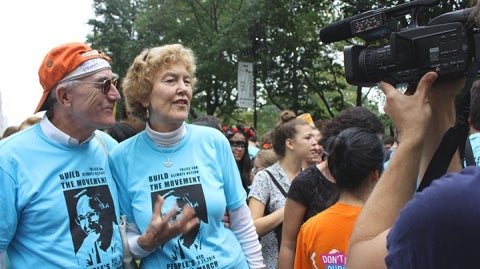The People’s Climate March on September 21 in New York was an amazing event.
So many people — over 310,000 with some estimates at 400,000.
So many groups — environmentalists, scientists, religious leaders, teachers, ordinary folk, and over 1,500 sponsors.
So many ages — mostly under 35 including 50,000 college students. But there were also people in wheel chairs and grandparents pushing strollers, marching for the next generation.
So much good energy and hope all around.
It was electrifying and hard to describe the emotions that washed over us during the day. We waited for an hour and a half for the march to begin as there were so many people who had assembled. We talked with the students from the Yale School of Forestry & Environmental Studies with whom we marched. They were filled with excitement, overflowing with a sense of solidarity, as were we. As we began to march we were all called to a collective moment of silence. And then from behind a vast roar, like a wave of unstoppable energy, swept over us.
We were buoyed by pictures along the route of those marching with us around the world in 160 countries where climate marches were taking place. The realization of the suffering already being caused by climate change was evident — from the Pacific Island nations, to those who weathered Sandy and Katrina, to those dealing with extreme droughts and floods.
This climate march, the largest in human history, was indeed a watershed moment. It demonstrated that people and planet are one force; and that climate justice and ecosystems preservation are part of a holistic way forward. The Earth community was visible there with such variety of humans and such boundless determination for protecting the Earth.
The religions were also present in a major way and it was deeply encouraging to witness their deepening commitment to the cause. There was a two day conference titled “
Religions for the Earth” that preceded the march at Union Theological Seminary in New York. It was organized by Karenna Gore and supported by the president of the seminary, Serene Jones. Terry Tempest Williams orchestrated a rich and inclusive final session.
Other organizations involved were the Parliament of World Religions, the Interfaith Center of New York, Green Faith, Interfaith Power and Light, the National Religious Partnership for the Environment, and the
Forum on Religion and Ecology at Yale.
Several key foundations contributed to the conference, including the Wallace Global Fund, which has divested from fossil fuels and the Rockefeller Brothers Fund, which
announced their divestment plans the day after the march. Both institutions are encouraging other foundations to follow suit saying climate change is a moral issue.
On Sunday evening after the march we participated in a celebration at the Cathedral of St. John the Divine with Paul Winter playing and Al Gore speaking. There religious leaders and laity pledged to make a difference on the climate change challenge. It was wonderful to see so many colleagues from this work over the years going all the way back to the Harvard conferences in the mid-90s, to those who supported the Earth Charter, to those at Yale Divinity School now.
The march began a week of meetings at the United Nations and elsewhere on the climate challenge. At the end of the week, on Sept. 28, the
New York Times ran an editorial in full support of the march, saying:
“It was important to put climate change back on the radar screen of world leaders, whose last effort to strike a deal, in Copenhagen five years ago, ended in acrimonious disaster. President Obama, for one, was as eloquent as he has ever been on the subject: ‘For all the immediate challenges that we gather to address this week — terrorism, instability, inequality, disease — there’s one issue that will define the contours of this century more dramatically than any other, and that is the urgent and growing threat of a changing climate.’”
This urgency captures the feeling at the march and with the religious leaders and academics at the Union Seminary conference and at the Cathedral of St. John the Divine. The hopes over several decades of the Forum on Religion and Ecology to become a dynamic field within academia and a transforming force within society
were realized last weekend in New York. Now to determine the ways forward to build collaboratively on the remarkable energies visible there!
Mary Evelyn Tucker and John Grim are co-directors of the Forum on Religion and Ecology at Yale.
 <p class="p1"> Mary Evelyn Tucker and Bill McKibben, co-founder of 350.org and a lead organizer of the People’s March, during the event.</p>
<p class="p1"> Mary Evelyn Tucker and Bill McKibben, co-founder of 350.org and a lead organizer of the People’s March, during the event.</p>
